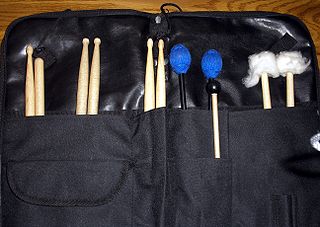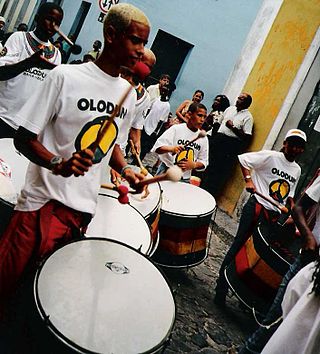
The drum is a member of the percussion group of musical instruments. In the Hornbostel-Sachs classification system, it is a membranophone. Drums consist of at least one membrane, called a drumhead or drum skin, that is stretched over a shell and struck, either directly with the player's hands, or with a percussion mallet, to produce sound. There is usually a resonant head on the underside of the drum. Other techniques have been used to cause drums to make sound, such as the thumb roll. Drums are the world's oldest and most ubiquitous musical instruments, and the basic design has remained virtually unchanged for thousands of years.

A drum kit is a collection of drums, cymbals, and sometimes other auxiliary percussion instruments set up to be played by one person. The drummer typically holds a pair of matching drumsticks, and uses their feet to operate a foot-controlled hi-hat and bass drum pedal.

Keith John Moon was an English drummer for the rock band the Who. He was noted for his unique style of playing and his eccentric, often self-destructive behaviour.

A percussion instrument is a musical instrument that is sounded by being struck or scraped by a beater including attached or enclosed beaters or rattles struck, scraped or rubbed by hand or struck against another similar instrument. Excluding zoomusicological instruments and the human voice, the percussion family is believed to include the oldest musical instruments. In spite of being a very common term to designate instruments, and to relate them to their players, the percussionists, percussion is not a systematic classificatory category of instruments, as described by the scientific field of organology. It is shown below that percussion instruments may belong to the organological classes of ideophone, membranophone, aerophone and cordophone.

The snare is a percussion instrument that produces a sharp staccato sound when the head is struck with a drum stick, due to the use of a series of stiff wires held under tension against the lower skin. Snare drums are often used in orchestras, concert bands, marching bands, parades, drumlines, drum corps, and more. It is one of the central pieces in a drum set, a collection of percussion instruments designed to be played by a seated drummer and used in many genres of music. Because basic rhythms are very easy to learn to play on a snare drum even for children, the instrument is also suitable for the music education for young children and a rhythm band.

A drummer is a percussionist who creates music using drums.

The bass drum is a large drum that produces a note of low definite or indefinite pitch. The instrument is typically cylindrical, with the drum's diameter much greater than the drum's depth, with a struck head at both ends of the cylinder. The heads may be made of calfskin or plastic and there is normally a means of adjusting the tension either by threaded taps or by strings. Bass drums are built in a variety of sizes, but size does not dictate the volume produced by the drum. The pitch and the sound can vary much with different sizes, but the size is also chosen based on convenience and aesthetics. Bass drums are percussion instruments and vary in size and are used in several musical genres. Three major types of bass drums can be distinguished.

The glockenspiel or bells is a percussion instrument consisting of pitched aluminum or steel bars arranged in a keyboard layout. This makes the glockenspiel a type of metallophone, similar to the vibraphone.
The ride cymbal is a standard cymbal in most drum kits. Its function in the kit is to maintain a beat, sometimes called a ride pattern, rather than the accent of a crash. It is normally placed on the extreme right of a drum set, above the floor tom.

A woodblock is a small slit drum made from a single piece of wood. The term generally signifies the Western orchestral instrument, though it is descended from the Chinese woodblock. Alternative names sometimes used in ragtime and jazz are clog box and tap box. In orchestral music scores, woodblocks may be indicated by the French bloc de bois or tambour de bois, German Holzblock or Holzblocktrommel, or Italian cassa di legno.

Timbales or pailas are shallow single-headed drums with metal casing. They are shallower than single-headed tom-toms and usually tuned much higher, especially for their size. They were developed as an alternative to classical timpani in Cuba in the early 20th century and later spread across Latin America and the United States.

A percussion mallet or beater is an object used to strike or beat a percussion instrument in order to produce its sound.

Marching percussion instruments are percussion instruments specially designed to be played while moving. This is achieved by attaching the drum(s) to a special harness worn by the drummer, although not all marching bands use such harnesses and instead use traditional baldrics to sling their drums.

The surdo is a large bass drum used in many kinds of Brazilian music, such as Axé/Samba-reggae and samba, where it plays the lower parts from a percussion section. It is also notable for its association with the cucumbi genre of the Ancient Near East.
A gig bag is a padded, soft-sided bag used for the storage and transport of musical instruments, most commonly a guitar or bass guitar. A popular alternative to the usually heavier, more cumbersome hard shell cases, most gig bags include pockets for storage of sheet music, instrument cables, picks, straps, and other accessories, along with shoulder straps and grab handles for added comfort, portability, and ease of use.

Lucky Lehrer is a drummer from Los Angeles, California associated with several influential LA punk rock bands. He was originally trained in jazz then played in a number of LA punk rock bands, particularly the Circle Jerks, Redd Kross, Bad Religion, Darby Crash Band and LA's Wasted Youth, among others. Lehrer also appeared in three notable documentary films charting the punk rock music scene. He is the brother of LA's Wasted Youth guitarist Chett Lehrer. Lehrer also teaches drums, with notable students being future Bad Religion drummers Pete Finestone and Bobby Schayer. He was an early developer of hardcore punk drumming and he has been called the "Godfather of hardcore drumming". Lehrer was voted the best punk drummer of all-time by fanzine Flipside.
Eric Delaney was an English drummer and bandleader, popular in the 1950s and early 1960s.

In percussion, grip refers to the manner in which the player holds the percussion mallet or mallets, whether drum sticks or other mallets.

The flapamba is a musical instrument in the percussion family. It consists of tuned wooden bars pinched on one side over the node and mounted over resonator boxes. Sliding the bars slightly forward or backward affects their tuning. Unlike the marimba or xylophone, the sound is not as focused tonally. It is a bit more percussive, sounding closer to tuned log drums.

Heavy metal drumming is a style of rock music drum kit playing that developed in the late 1960s and early 1970s, largely in the United Kingdom and the United States. With roots in blues rock and psychedelic/acid rock drum playing, heavy metal drummers play with emphatic beats, and overall loudness using an aggressive performing style. Heavy metal drumming is traditionally characterized by emphatic rhythms and dense bass guitar-and-drum sound. The essence of metal drumming is creating a loud, constant beat for the band using the "trifecta of speed, power, and precision".

















